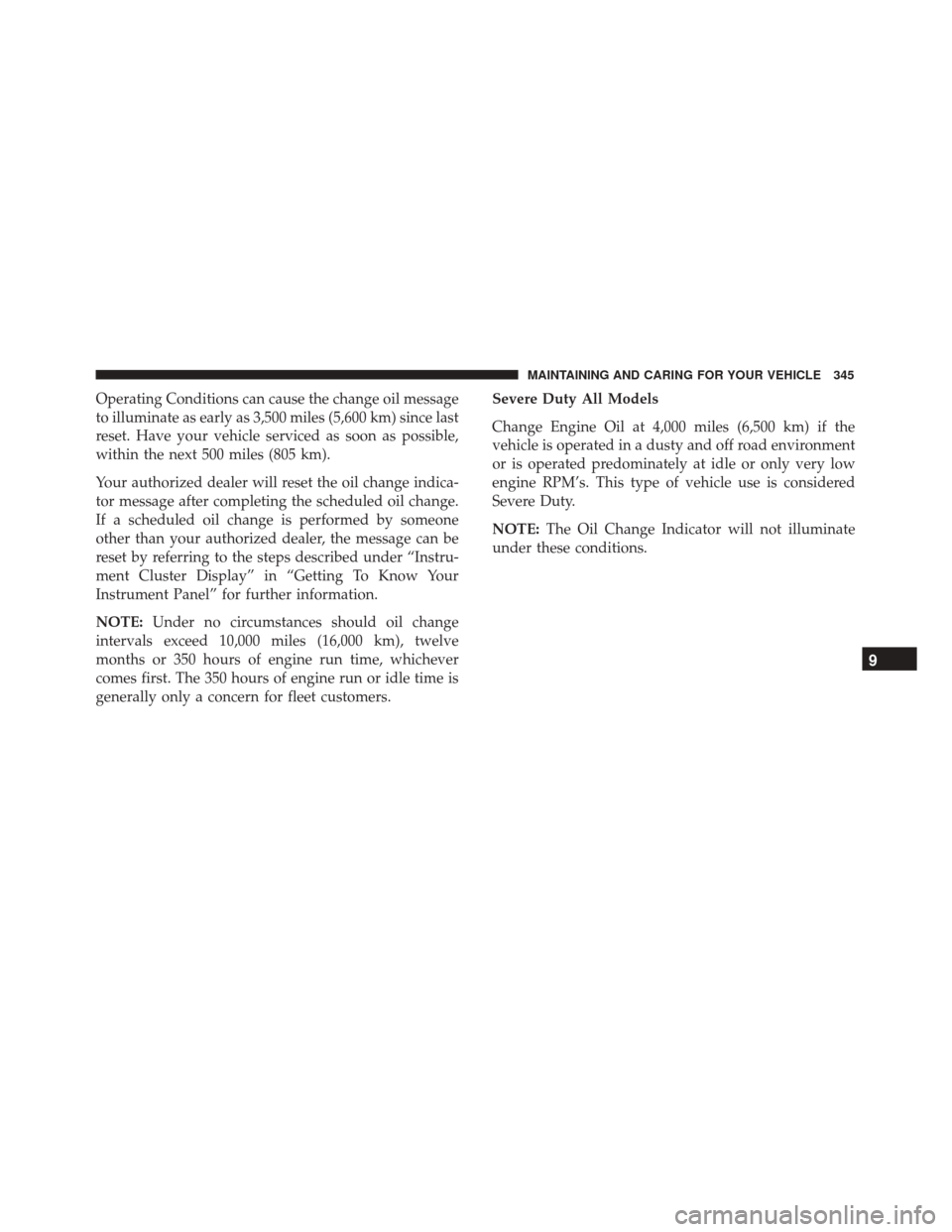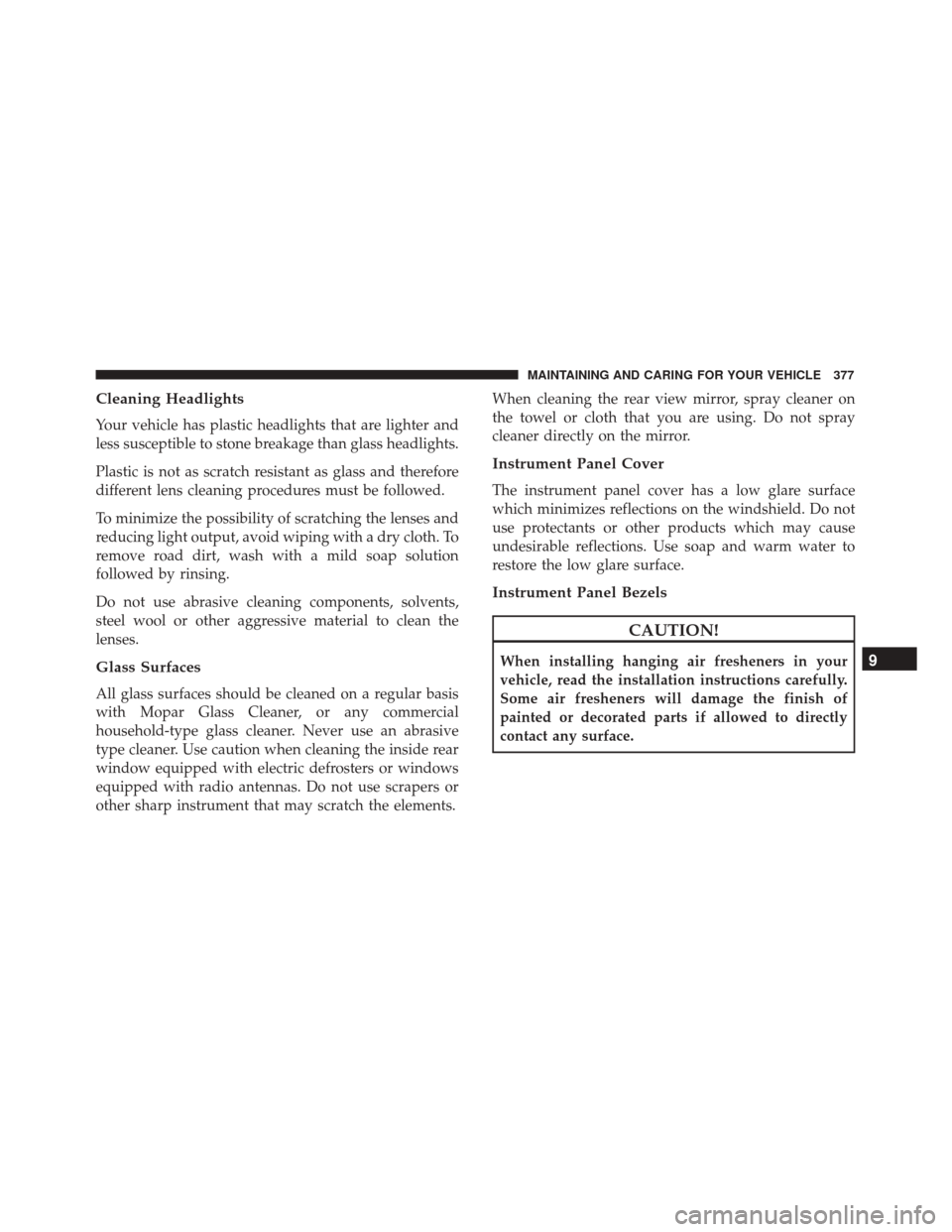Page 250 of 476

Detection Distances
If the sensors detect more obstacles, it is taken into
account only what is the shorter distance.
Instrument Cluster Display
ParkSense is displayed on the instrument cluster only if
you have selected the item�Sound And Display�inside
the �Settings� menu of the Uconnect system.
If an obstacle is detected in the center rear region, the
display will show a single solid arc in the center rear
region and will produce a one-half second tone. As the
vehicle moves closer to the obstacle, the display will
show the single arc moving closer to the vehicle and the
sound tone will change from slow, to fast, to continu-
ous.
If an obstacle is detected in the left and/or right rear
region, the display will show a single flashing arc in the
left and/or right rear region and will produce a fast
sound tone. As the vehicle moves closer to the obstacle,
the display will show the single arc moving closer to the
vehicle and the tone will change from fast to continu-
ous. In general, the car is closest to the obstacle when the
display shows only a flashing arc and the chime be-
comes continuous.
The color on the display depends on the distance and
location of the obstacle.
Enabling And Disabling ParkSense
ParkSense can be enabled and disabled with the
ParkSense switch.
When the ParkSense switch is pushed to
disable the system, the instrument cluster will
display the “PARKSENSE OFF” message for
approximately five seconds. Refer to “Instru-
ment Cluster Display” in “Getting To Know Your
Instrument Panel” for further information. When the
gear selector is moved to REVERSE and the system is
disabled, the instrument cluster display will show the
“PARKSENSE OFF” message for as long as the vehicle
is in REVERSE.
The ParkSense switch LED will be on when ParkSense
is disabled or requires service. The ParkSense switch
LED will be off when the system is enabled. If the
248 STARTING AND OPERATING
Page 251 of 476

ParkSense switch is pushed, and requires service, the
ParkSense switch LED will blink momentarily, and then
the LED will be on.
ParkSense will remember the previous state when the
vehicle is switch off.
CAUTION!
After turning the ignition to STOP, the ParkSense
remains in this setting until the next key cycle. This
is true even in the case of changing the ignition
from RUN to STOP, and then again to RUN.
Service The Rear Park Assist System
During vehicle start up, when the ParkSense Rear Park
Assist System has detected a faulted condition, the
instrument cluster will actuate a single chime, once per
ignition cycle, and it will display a dedicated message
such as “PARK ASSIST UNAVAILABLE WIPE REAR
SENSORS” or the “PARK ASSIST UNAVAILABLE SER-
VICE REQUIRED” message. Refer to “Instrument Clus-
ter Display” in “Getting To Know Your Instrument
Panel” for further information. When the gear selector
is moved to REVERSE and the system has detected a
faulted condition, the instrument cluster display willdisplay a dedicated message such as
�PARK ASSIST
UNAVAILABLE WIPE REAR SENSORS� or
�PARKSENSE UNAVAILABLE SERVICE REQUIRED �
message for as long as the vehicle is in REVERSE.
Under this condition, Rear Park Assist will not operate.
If a message such as “PARK ASSIST UNAVAILABLE
WIPE REAR SENSORS” appears in the instrument
cluster display, make sure the outer surface and the
underside of the rear fascia/bumper is clean and clear
of snow, ice, mud, dirt or other obstructions, and then
cycle the ignition. If the message continues to appear,
see an authorized dealer.
If a message such as “PARK ASSIST UNAVAILABLE
SERVICE REQUIRED” appears in the instrument clus-
ter display, see an authorized dealer.
ParkSense System Usage Precautions
NOTE:
• Ensure that the outer surface and the underside of
the rear bumper is clean and clear of snow, ice, mud,
dirt or other obstruction to keep the Rear ParkSense
system operating properly.
• Jackhammers, large trucks, and other vibrations
could affect the performance of Rear ParkSense.
7
STARTING AND OPERATING 249
Page 275 of 476

If the “SERVICE POWER STEERING�OR
�POWER STEERING ASSIST OFF - SERVICE
SYSTEM” message and a steering wheel icon
are displayed on the instrument cluster screen, it indi-
cates that the vehicle needs to be taken to the dealer for
service. It is likely the vehicle has lost power steering
assistance. Refer to “Instrument Cluster Display” in
“Getting To Know Your Instrument Panel” for further
information.
NOTE:
• Even if the power steering assistance is no longer
operational, it is still possible to steer the vehicle.
Under these conditions there will be a substantial
increase in steering effort, especially at low speeds
and during parking maneuvers.
• If the condition persists, see your authorized dealer
for service.
TRAILER TOWING
In this section you will find safety tips and information
on limits to the type of towing you can reasonably do
with your vehicle. Before towing a trailer, carefully
review this information to tow your load as efficiently
and safely as possible. To maintain the New Vehicle Limited Warranty cover-
age, follow the requirements and recommendations in
this manual concerning vehicles used for trailer towing.
Common Towing Definitions
The following trailer towing related definitions will
assist you in understanding the following information:
Gross Vehicle Weight Rating (GVWR)
The GVWR is the total allowable weight of your vehicle.
This includes driver, passengers, cargo and tongue
weight. The total load must be limited so that you do
not exceed the GVWR. Refer to “Vehicle Loading/
Vehicle Certification Label” in “Starting And Operat-
ing” for further information.
Gross Trailer Weight (GTW)
The GTW is the weight of the trailer plus the weight of
all cargo, consumables and equipment (permanent or
temporary) loaded in or on the trailer in its
�loaded and
ready for operation� condition.
The recommended way to measure GTW is to put your
fully loaded trailer on a vehicle scale. The entire weight
of the trailer must be supported by the scale.
7
STARTING AND OPERATING 273
Page 309 of 476
Access To The Fuses
The fuses are grouped into four controllers located in
the engine compartment, under the instrument panel
and on the inside of the left side cargo trim panel.
Engine Compartment Fuses/Distribution Unit
The engine compartment fuse panel is located on the
left side of the engine compartment.Removing Fuse Cover and Locking Screw
Proceed as follows:
1. Slowly turn the screw counterclockwise.
2. Slowly release the screw.
3. Remove the fuse cover by sliding it upward.
Engine Compartment Fuse Cavities
Fuse Panel And Cover Location
1 — Mounting Screw
2 — Fuse Cover8
IN CASE OF EMERGENCY 307
Page 314 of 476
Body Computer Fuse Center
The controller is located at the left side of the steering
column at the bottom of the instrument panel.
For the fuse replacement see your authorized dealer.
Body Controller Fuse Cavities
312 IN CASE OF EMERGENCY
Page 347 of 476

Operating Conditions can cause the change oil message
to illuminate as early as 3,500 miles (5,600 km) since last
reset. Have your vehicle serviced as soon as possible,
within the next 500 miles (805 km).
Your authorized dealer will reset the oil change indica-
tor message after completing the scheduled oil change.
If a scheduled oil change is performed by someone
other than your authorized dealer, the message can be
reset by referring to the steps described under “Instru-
ment Cluster Display” in “Getting To Know Your
Instrument Panel” for further information.
NOTE:Under no circumstances should oil change
intervals exceed 10,000 miles (16,000 km), twelve
months or 350 hours of engine run time, whichever
comes first. The 350 hours of engine run or idle time is
generally only a concern for fleet customers. Severe Duty All Models
Change Engine Oil at 4,000 miles (6,500 km) if the
vehicle is operated in a dusty and off road environment
or is operated predominately at idle or only very low
engine RPM’s. This type of vehicle use is considered
Severe Duty.
NOTE:
The Oil Change Indicator will not illuminate
under these conditions.
9
MAINTAINING AND CARING FOR YOUR VEHICLE 345
Page 353 of 476
Mileage or time passed
(whichever comes first)
10,000
20,000
30,000
40,000
50,000
60,000
70,000
80,000
90,000
100,000
110,000
120,000
130,000
140,000
150,000
Or Years: 1 2 3 4 5 6 7 8 9 10 11 12 13 14 15
Or Kilometers:
16,000
32,000
48,000
64,000
80,000
96,000
112,000
128,000
144,000
160,000
176,000
192,000
208,000
224,000
240,000
Flush and replace the engine
coolant at 10 years or
150,000 miles (240,000 km)
whichever comes first. ••
Replace the timing belt (1.4L
Turbo Engine). •
�
Recommend replacement
• Mandatory service
# The engine air cleaner should be inspected at every
oil change if used in dusty areas.
* The oil and oil filter replacement must be carried out
when indicated by a warning light or message on the
instrument panel, or in any case should not exceed 1
year or 10,000 miles (16,000 km).
9
MAINTAINING AND CARING FOR YOUR VEHICLE 351
Page 379 of 476

Cleaning Headlights
Your vehicle has plastic headlights that are lighter and
less susceptible to stone breakage than glass headlights.
Plastic is not as scratch resistant as glass and therefore
different lens cleaning procedures must be followed.
To minimize the possibility of scratching the lenses and
reducing light output, avoid wiping with a dry cloth. To
remove road dirt, wash with a mild soap solution
followed by rinsing.
Do not use abrasive cleaning components, solvents,
steel wool or other aggressive material to clean the
lenses.
Glass Surfaces
All glass surfaces should be cleaned on a regular basis
with Mopar Glass Cleaner, or any commercial
household-type glass cleaner. Never use an abrasive
type cleaner. Use caution when cleaning the inside rear
window equipped with electric defrosters or windows
equipped with radio antennas. Do not use scrapers or
other sharp instrument that may scratch the elements.When cleaning the rear view mirror, spray cleaner on
the towel or cloth that you are using. Do not spray
cleaner directly on the mirror.
Instrument Panel Cover
The instrument panel cover has a low glare surface
which minimizes reflections on the windshield. Do not
use protectants or other products which may cause
undesirable reflections. Use soap and warm water to
restore the low glare surface.
Instrument Panel Bezels
CAUTION!
When installing hanging air fresheners in your
vehicle, read the installation instructions carefully.
Some air fresheners will damage the finish of
painted or decorated parts if allowed to directly
contact any surface.9
MAINTAINING AND CARING FOR YOUR VEHICLE 377